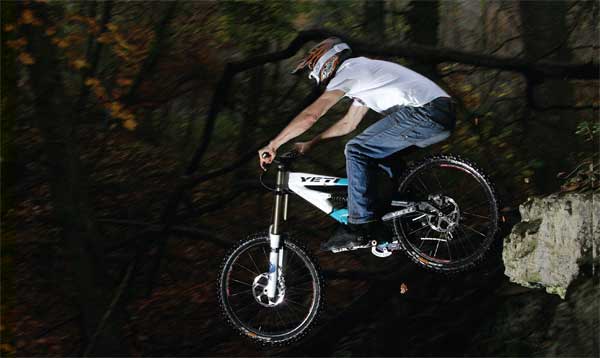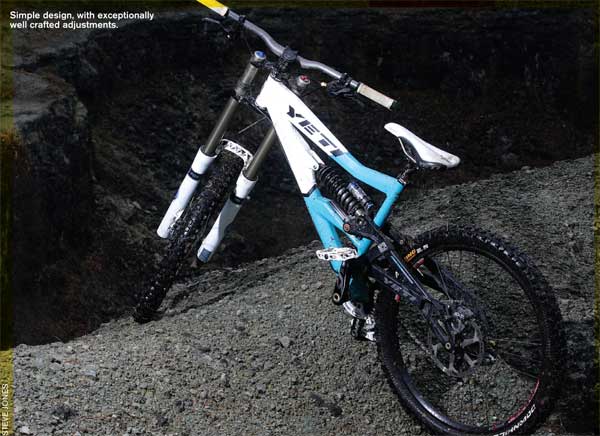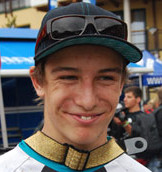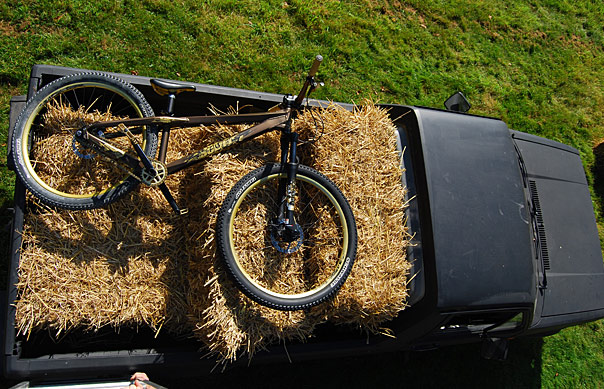
BIKE TEST Sam Blenkinsop’s Yeti 303 and Yeti RDH
It is vitally important from the outset to get across what the Yeti 303 is and what it is not. Therefore to progress from this point it is important to read the Yeti 303 FAQ’s and answers on their website, www.yeticycles.com. The answers give a concise and thorough run down of the theory behind this bike. The reality is pretty much all of what they say, and this particular bike is even more than that. Three years ago these pages hinted that the 303 was a complex bike. That test still stands. And such a high altitude, big terrain bike as the 303 is not particularly at home nibbling around in the lowland on tight, rooty, and most importantly, slow, tracks. Whether they be in the UK or the foothills of Osogovska. That’s for the new RDH, but more of that later.
Just like the inconclusive pages of this magazine bugged the importers as much as the on–looking engineers lost sleep over what effect mud would
have on the beautiful sliding linkages, it was still well made. But whilst we hinted that it might just be at home in the harder faster cauldron of a true race venue, at the time we were not able to fully explore the bike in that type of terrain. Times change. And so do bikes. So lets get it straight. If I had to choose a bike to ride the Schladming track, slightly tortuous in places, but a flowing and choppy ride, one that prompted Gee Atherton to proclaim it a ‘man’s track in the wet’, then this is the bike I would choose to ride it on.

Taking into account that slow, tight, wet and stinky will always be close to my heart, this day was surely one of the best possible ways to test bikes. A full hand of team mechanics, suspension experts front and rear from Fox Racing and the guys who really make it count – the likes of Yeti team riders Sam Blenkinsop, Justin Leov and Aaron Gwin. This bike was completely unexpected in so many ways. It caught me…unexpectedly. And many others. What we have here then is the bike that took the New Zealander to the very highest place on the downhill planet. A race not hewn out of a big old pedal down a Land Rover track not so far from his house, but one that mixed speed with cambers, root with corners, and braking bumps with precise line choice. Blenkinsop’s Schladming win was immense.
As mentioned a few years ago the Yeti appeared on test in a slow and twisted woods near Betws y Coed. It was also the wrong size. Hell even this large comes up on the shortish
side. And it was a complex beast back then. We could only leave with first impressions given the time it would take to work out shock settings on such a multi theory system. These two factors contributed to leave me without any real conclusion about the bike. Not ideal. It is still that same bike, although in a revised form. New shock, larger bike, better forks – pretty different actually. Yeti point out that they have gone through many, many prototypes to get to this stage and have learned significantly with their team connection with Fox suspension. The important thing to remember is that it works completely differently to most of the traditional forms of suspension designs, be it single pivot, linked, Horst’ed, virtualled or whatever – trying to push against a damping platform on the Yeti ain’t gonna happen. Upside down to that, and in a roundabout way, Yeti themselves say that the 303 isolates the rider from forces from the ground up. This kind of hints at something a bit different to traditional systems, after all that is a BIG thing to say of a bicycle. Without much thought, other than anything except maybe it was actually the size for me and a quick check, revealed about 40% sag I legged it to the chairlift with Blenkinsop’s bike, chucked it on and dropped in at 1350m, just on the snowline, mid September. Schladming is a reasonably big track. Out of the gate it throws you down a bank into an endless wave of holes and then a shed load of root. I had ridden another well known race bike this day, a beautiful machine with supple, compliant…actually hold the clichés…it’s difficult to describe the suspension. It was good. Real good. I’d kind of got this crazy idea however that bicycles, no matter what variety, will always be chucked about deep into the holes that roam the alpine slopes. It’s only a bit of metal after all.

So, laced with coffee there I was tipping the 303 over the brow of Planai. For a second I held my breath just waiting for the ensuing five minute beating. For starters it’s difficult enough up front to find a balance between a bike that dives front first into these holes and one that hits them too hard with too firm a spring or compression rate. What happens up front then affects what goes on behind. Out the back it’s true to say you can feel the damping working on most traditional design bikes. For example, the new Fox shock has four times the oil flow of the old DHX yet you can still feel the connections on most bikes. Anyhow it was time to forget the theories – there was this fucking wave of holes spilling down the hill ahead of me. I was preparing to take the hits, make up excuses, complain of cold hands and aching arms. Instead I was only inspired. The holes didn’t happen. One sniff of a braking bump and the Yeti breathed into life. None of that vibration that begins in the wheels and slowly creeps up through the soles of your feet and into your head. Oh no, this was great. This fucking bike was accelerating through the whoops. What the hell? Had the ground softened, was it because I was warmed up, maybe I’d learned the track, shit was I on a different line? It was as if someone had removed every bone in my body and filled it with thick fresh Italian olive oil. “What do you reckon?” asked Sam and Justin down at the truck as I threw off my wet jacket and was handed some hot tea. With no time to waste I headed back up. “See you in a bit.” If there was ever an auto pilot rear end of a bike this is it.
Later on I took the tea and continued the conversation. “We chose to ride the 303 and not the new single pivot because it’s just sick on this track, you can get really loose on it”. I could only agree with him. I doubt there is any production bike that’ll touch the Yeti on braking bumps. But how come this was one of the weaknesses on the previous 303 I’d ridden? Centre of gravity due to size maybe? Poor suspension set up because of time needed. Lesson learned. But remember too that this was Blenkinsop’s first time out on a large
and he pops out on the top of the podium!
There is a very definite way to ride this bike. Loose is probably how most people would describe it. And for much of the track, one like Schladming anyway, you can get away with this. It appears to move in a suspended but controlled drift that always ends in grip. But that’s the one downside I can see in this bike. At some point you have to rely on pressure through the frame and suspension to find grip and gain speed. It’s good to have progression in the traditional one–dimensional (or three) sense of the word because it allows a rider to feel his or her way into the soul of the track. This varies from hill to hill. Having the option of a simple single pivot and top–drawer suspension as an alternative puts this team in an incredibly strong position equipment wise. Yeti acknowledge this, “Our World Cup team has been riding both models, the 303DG and 303R-DH depending on the course.” On the 303 you almost have to change your reference points on the track. It also encourages riding over the front more and in my case that’s a good thing. But the front of Sam’s bike was a touch too soft for me, so I upped spring rate. Without knowing the Fox guys upped me several rates to a yellow – probably because that’s what the figures say, but the reality was in fact a hard fork that upset the rear end quite badly. More food for thought. More time needed up front. On the rear Blenkinsop’s 450 weight spring worked perfectly with this slower rider on board. I still can’t get over how good the back of that bike was.

WEIGHTS AND MEASURES
Many were surprised at the 42.5lb billing of the Yeti. That’s pretty light for something so complex. Roughly within a pound of Minnaar, Peat and Atherton’s bikes in fact. At 46.75” on the wheelbase it’s within a quarter inch of Gee’s Commencal. We rode the bike with Blenky’s head angle preference, which was at its maximum of 64 degrees, dishing out a 14” bottom bracket. Half inch lower, a degree steeper as a comparison of the two large bikes we had that day. The chainstay was pretty standard at just over 17.5 inches. The most telling factor I found was the head angle measurement. When the digital angle finder is set on the fork leg very few bikes settle on a reading immediately (I’m guessing because it only measures to tenths then anything outside that is difficult). “64?” I shouted to Damien from Yeti? Bang on. A quality engineered bicycle.
CONCLUSION
You have to remember the environment that this test took place. It had a full factory presence and the bike had been fine tuned for a flat pedal rider with the ultimate in stiction free damping. And lucky to be presented with settings pretty much close to what I’d have used anyway on this day. Atherton’s Commencal (that I also rode) was just a touch on the hard side for me, with him being a faster rider of almost the same weight. Although it’s incredibly difficult to get a real feel for the damping on the back of the Yeti as you would on most bikes, it really is a bike for seriously pushing and pushing some more. Use the isolation of rear ground forces to your advantage. It’s only when you stop considering what the back is doing that you begin to let the Yeti roll. In this respect I’d also seriously think about relying entirely on the expertise of Fox to give you suspension setting information to a certain degree, or a lot of testing. The first place I’d head to with this bike would be big, fast, heavy hitting terrain and leave the nibbling around the lowland woods for the locals.
The 303 then, a specialist bike to a certain degree, a bike that anyone riding bigger faster Alpine terrain should consider. At £3499.00 it’s a lot of money, but the quality shows. One day it will probably become collectable, but for now it remains a weapon in Blenkinsop’s armoury. In fact looking at the race schedule, whoever rides on the Yeti team next year is a very lucky person. z
Price: Production 303 £3499
Evolution 0208 290 0807
www.yeticycles.com

After possibly the most successful ever race season for Yeti bikes, one in which Blenkinsop, Leov and Gwinn took the Yeti to increasingly higher places, the company has brought
to production the simpler of the two bikes, bikes that frequently gained incredible top ten places…the 303RDH. The aim was always to make something simpler and more affordable with the 303 RDH. They’ve done that, but most importantly the bike retains its Yeti charm. Great colour, quality finish and just that little tiny bit different. It’s lighter, involves less maintenance and has fewer bolts than the 303, but still gets the patented ‘Zero Loss’ involved in the game of keeping the wheels moving.
TECH
The bike is basically a single pivot (SP) coupled with a linear rail and push links. These additions, if you like, to the SP has two roles: 1) It controls the shock rate and 2) optimizes shock rate, lateral stiffness and keeps the weight low down. Yeti say that in order to achieve this kind of characteristic using only links there would be very long bits of metal involved. Just as important than those two features is the fact that it limits the rotation of the shock during a run and clearly leads to longer shock life and increased suspension efficiency. It’s a nice touch and hell, there’s no end of bike designs that give the modern day shock a right working over. Yeti have matched the instantaneous leverage ratio of the 303 DH and have also included a degree of adjustability into the design. 64–65 head angle, dependent on fork length obviously, and a 13.85” to 14.35” bottom bracket height. The adjustment is incredibly easy to use, but importantly, by using the linear rail it means there is hardly any change in travel or instantaneous leverage ratio with any changes made. Most riders would be looking to run the lower slacker geometry and not really bother with the higher and steeper mode. What we do like is the engineered feel of the Yeti, the engravings that tell the rider where they’re at on the hill in terms of how much suspension has been used. It’s also interesting that they have taken on the responsibility of a full build kit. Lets have a look what you’re getting: Custom Fox 40 with steel spring, Cane Creek S–3 headset, Truvativ Hussefelt cranks, stem, and bar, e.thirteen SRS guide, Sram X.9 gears and X.7 shifting, Sram 11-26 cassette and chain, Mavic Dee traks wheels, Maxxis Minion 2.5’s and Avid Elixir 203 brakes. Not the lightest, but a rugged and reliable build. That’s Yeti all over.
RIDER
Yeti have headed down the single pivot route with this bike, but have introduced a large degree of progression into the system by way of the link. Out on the track the bike moves across the ground particularly rapidly as the rider is taken care of in terms of small to medium root and rock with the super supple first quarter of the travel. Pass this mark and the progression moves into action enabling ultra fast exiting of berms and super quick pick up of the bike to avoid the bigger collisions. The large test bike had plenty of room to get really involved with pedalling should the need arise. Most of the angles all add up, as do most of Yeti’s varieties, and this large is a good size for riders around the six foot marker. The same as the 303. The adjustable head angle/bottom bracket set up is an excellent idea and very easy to use. However I feel the 64 head angle setting is the one best suited to this big travel bike and that should take preference in downhill situations. And when you are in those places the bike works well. On the flatter terrain and gentler sloping corners the relatively short back end, whilst silently going about its business, does tend to place the rider with a slightly further than needed rearward bias. I’m not entirely convinced on the proportions of the RDH front and rear on the large, but like I said, on the steep stuff that’s fine because you’d be buzzing the seat anyway, it’s just that
on the slacker stuff there needs to be a touch of counterbalancing to make sure enough weight is presented onto the bar and therefore tyre. what of the suspension? Quite definitely the best production Fox 40 fork I have ridden. And seeing as the build comes with this custom option that’s a huge plus in its favour. Out the back the Fox DHX is OK, and for the price I guess it works well enough, but I can’t help but feel there will be a touch of twitching in favour of the newer Fox unit that will undoubtedly surface at some point. And it feels like the transition in the progression might be a bit coarse at the moment for some riders. Particularly on extended big hitting root sections there could be a touch more in the middle so to speak. Difficult call this because on most tracks it ain’t even going to be an issue, but it might become quite bumpy on longer trips. That said it does allow the bike to maintain a reasonably stable geometry and great speed, which is always a good thing. That pretty much sums up the feeling out of the box really.
CONCLUSION
An interesting variation on the single pivot, the bike carries off the Yeti flag very well indeed. The adjustable geometry will be right up many people’s street and its speed potential on certain tracks needs no questioning. Whilst the change in wheelbase varies very little with changes made to head angle and bottom bracket is a good thing, I don’t feel the shape and angles are 100% just yet, but then it’s mighty close. The sizing on the large is pretty good for a six–foot rider, at an inch less on the wheelbase it will be interesting to how the medium works out on the hill. The fact that many team riders went large towards the end of the year might channel a lot of riders down the longer route. All in all though a very good bike, and with the close link to Fox I just can’t wait for the new DH damper unit to arrive to step things
up even further.
Price: Production 303 RDH Frame £1999
Complete £3650 (contact Evolution for full spec)
Contact: Evolution 0208 290 0807
www.yeticycles.com








